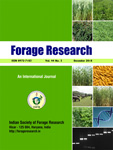B. B. TANDEL, R. M. PANKHANIYA*, S. K. PARMAR, V. G. BAVALGAVE AND H. M. VIRDIA
Department of Agronomy,
N. M. College of Agriculture, Navsari Agricultural University, Navsari (Gujarat), India
*(e-mail: rameshpankhania@nau.in)
(Received : 22 February 2025; Accepted : 21 March 2025)
SUMMARY
A field trial was conducted during the rabi season of 2017-18 to 2019-20 at Instructional
Farm, Department of Agronomy, N. M. College of Agriculture, Navsari Agricultural University, Navsari,
Gujarat to study the weed dynamic and fodder yield of oat as affected by sowing technique and
weed management practices. The experiment consists of two sowing methods, S1: Line sowing and
S2: Cross sowing, five weed management treatments, W1: Unweeded control, W2: Weed-free (Two
HW at 20 & 40 DAS), W3: Pendimethalin @ 1 kg/ha PE, W4: 2,4-D amine salt @ 0. 5 kg/ha as PoE at
30 DAS and W5: Metsulfuron methyl @ 4 g/ha as PoE30 DAS. A total of ten treatment combinations
were laid out in factorial randomized block design (FRBD) with three replications. A Significant
reduction in weed density and weed biomass was observed with cross sowing method. Among the
herbicide treatments, Metsulfuron methyl @ 4 g/ha as PoE30 DAS resulted in significantly lower
density and dry weight of weeds. This treatment recorded maximum weed control efficiency (WCE)
(80.18 %), while a lower weed competition index was recorded with Pendimethalin @ 1 kg/ha PE,
followed by Metsulfuron methyl (WCI) (2.23).
Key words: Sowing technique, weed dynamic, weed count and weed dry weight

